Kodak's Business Strategies in the Photography Industry - Report
VerifiedAdded on 2023/06/09
|20
|5371
|332
Report
AI Summary
This report investigates Kodak's strategies for maintaining its presence in the photography industry despite the emergence of digital cameras. It outlines the company's objectives, research methodology, and the factors contributing to its sustained operations, such as new market opportunities, cost-effective labor, raw material availability, and profit maximization. The report also highlights the importance of Kodak's reputation, experience, and customer service in retaining customers amidst competition. Ultimately, the paper aims to identify the root causes behind Kodak's continued success and provide insights into the company's strategic approach to navigate the evolving photography landscape.
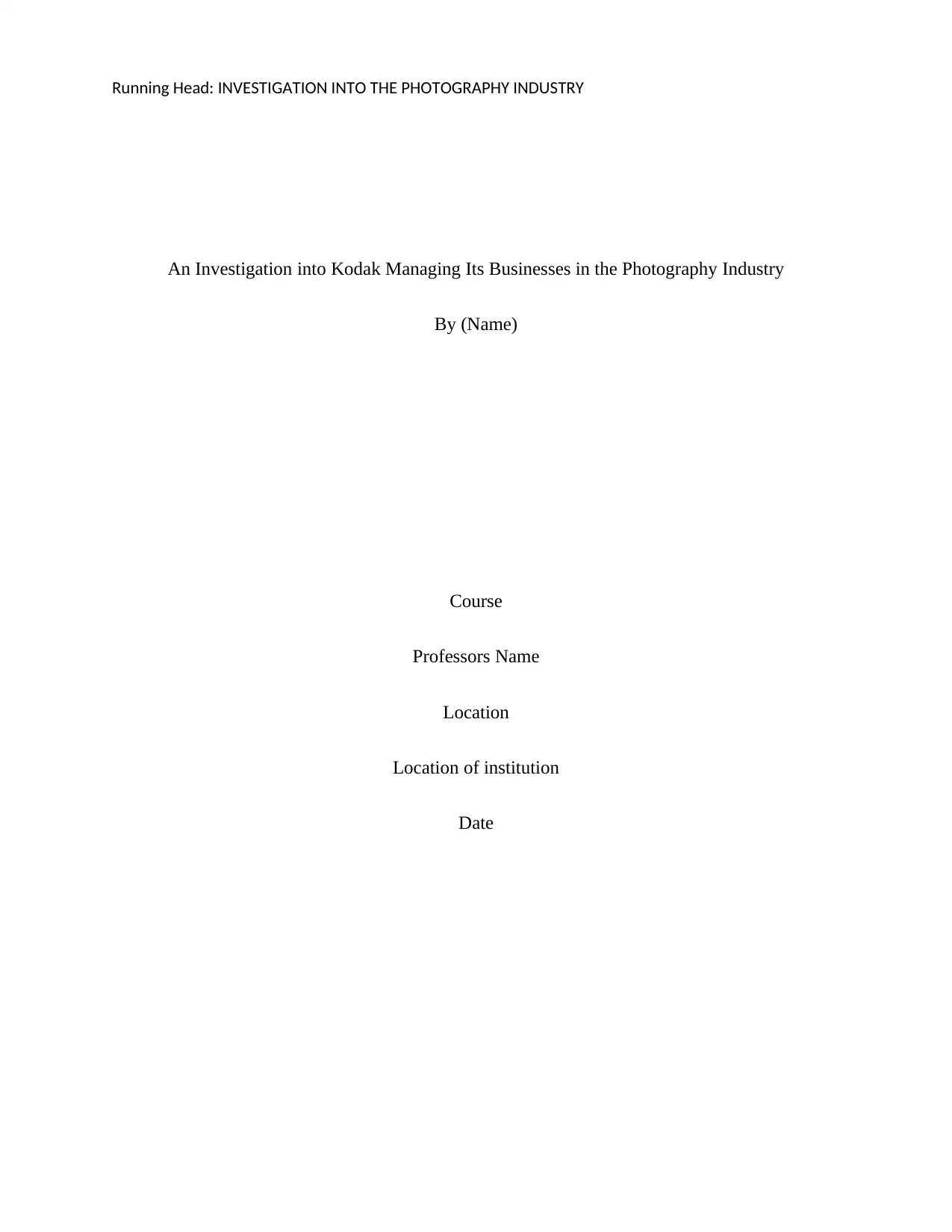
Running Head: INVESTIGATION INTO THE PHOTOGRAPHY INDUSTRY
An Investigation into Kodak Managing Its Businesses in the Photography Industry
By (Name)
Course
Professors Name
Location
Location of institution
Date
An Investigation into Kodak Managing Its Businesses in the Photography Industry
By (Name)
Course
Professors Name
Location
Location of institution
Date
Paraphrase This Document
Need a fresh take? Get an instant paraphrase of this document with our AI Paraphraser

AN INVESTIGATION INTO THE PHOTOGRAPHY INDUSTRY 2
An investigation of how Kodak has managed to maintain a presence in the photography industry
despite competition from new entrants such as the digital camera
TABLE OF CONTENTS
INTRODUCTION…………………………………………………………………….2
LITERATURE REVIEW………………………………………………………….….3
RESEARCH PLAN…………………………………………………………….……..4
RESEARCH AIMS AND OBJECTIVES……………………………………..5
RESEARCH PHILOSOPHY………………………………………………….6
RESEARCH PROPOSAL……………………………………………………7
RESEARCH NATURE……………………………………………………….8
METHODOLOGICAL STRATEGIES……………………………………….9
SAMPLING………………………………………………………………….10
TIME FRAME……………………………………………………………….11
ACCESS AND ETHICAL ISSUES………………………………………….12
IMPLEMENTATION TIME PLAN…………………………………………13
CONCLUSION…………………………………………………………………..14
REFERENCES…………………………………………………………………...15
An investigation of how Kodak has managed to maintain a presence in the photography industry
despite competition from new entrants such as the digital camera
TABLE OF CONTENTS
INTRODUCTION…………………………………………………………………….2
LITERATURE REVIEW………………………………………………………….….3
RESEARCH PLAN…………………………………………………………….……..4
RESEARCH AIMS AND OBJECTIVES……………………………………..5
RESEARCH PHILOSOPHY………………………………………………….6
RESEARCH PROPOSAL……………………………………………………7
RESEARCH NATURE……………………………………………………….8
METHODOLOGICAL STRATEGIES……………………………………….9
SAMPLING………………………………………………………………….10
TIME FRAME……………………………………………………………….11
ACCESS AND ETHICAL ISSUES………………………………………….12
IMPLEMENTATION TIME PLAN…………………………………………13
CONCLUSION…………………………………………………………………..14
REFERENCES…………………………………………………………………...15
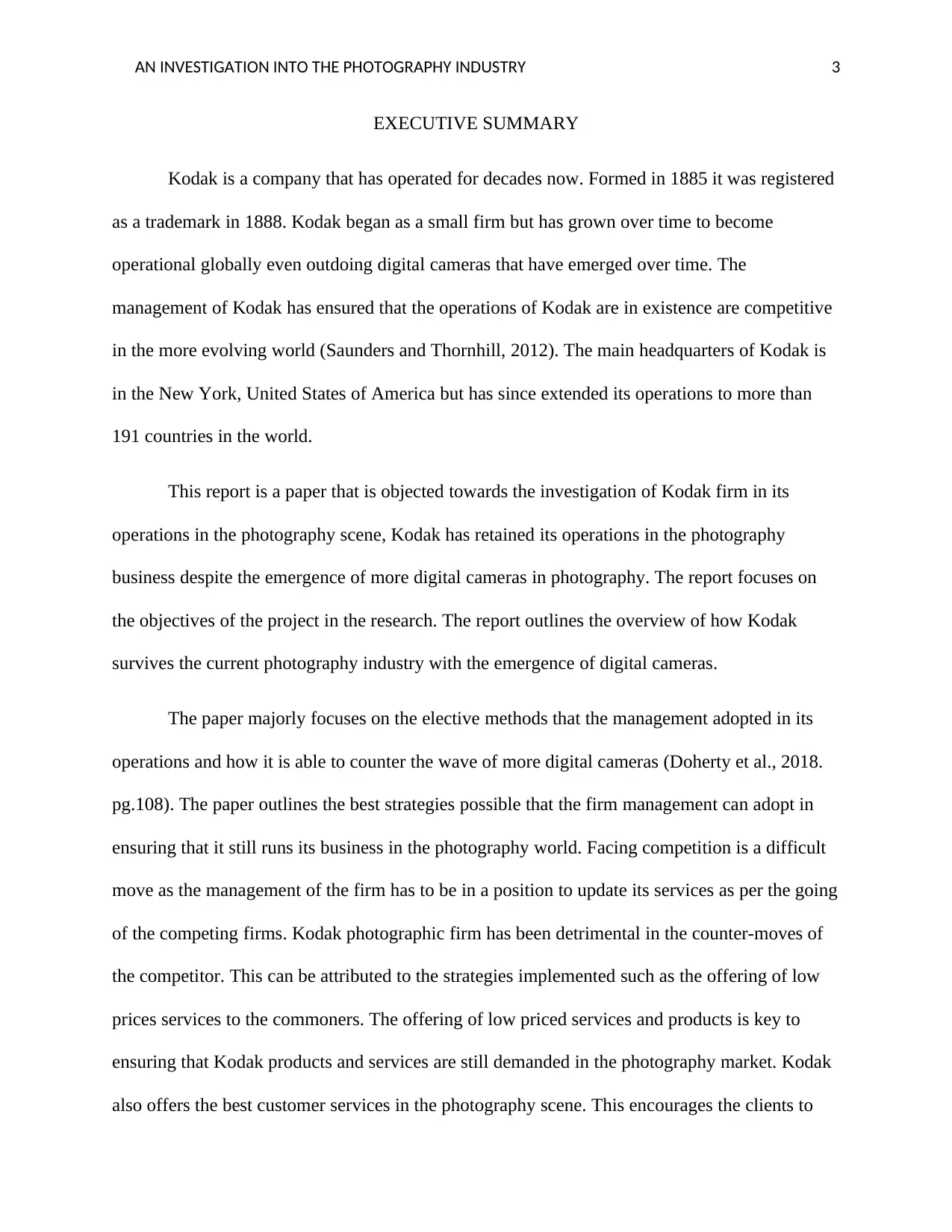
AN INVESTIGATION INTO THE PHOTOGRAPHY INDUSTRY 3
EXECUTIVE SUMMARY
Kodak is a company that has operated for decades now. Formed in 1885 it was registered
as a trademark in 1888. Kodak began as a small firm but has grown over time to become
operational globally even outdoing digital cameras that have emerged over time. The
management of Kodak has ensured that the operations of Kodak are in existence are competitive
in the more evolving world (Saunders and Thornhill, 2012). The main headquarters of Kodak is
in the New York, United States of America but has since extended its operations to more than
191 countries in the world.
This report is a paper that is objected towards the investigation of Kodak firm in its
operations in the photography scene, Kodak has retained its operations in the photography
business despite the emergence of more digital cameras in photography. The report focuses on
the objectives of the project in the research. The report outlines the overview of how Kodak
survives the current photography industry with the emergence of digital cameras.
The paper majorly focuses on the elective methods that the management adopted in its
operations and how it is able to counter the wave of more digital cameras (Doherty et al., 2018.
pg.108). The paper outlines the best strategies possible that the firm management can adopt in
ensuring that it still runs its business in the photography world. Facing competition is a difficult
move as the management of the firm has to be in a position to update its services as per the going
of the competing firms. Kodak photographic firm has been detrimental in the counter-moves of
the competitor. This can be attributed to the strategies implemented such as the offering of low
prices services to the commoners. The offering of low priced services and products is key to
ensuring that Kodak products and services are still demanded in the photography market. Kodak
also offers the best customer services in the photography scene. This encourages the clients to
EXECUTIVE SUMMARY
Kodak is a company that has operated for decades now. Formed in 1885 it was registered
as a trademark in 1888. Kodak began as a small firm but has grown over time to become
operational globally even outdoing digital cameras that have emerged over time. The
management of Kodak has ensured that the operations of Kodak are in existence are competitive
in the more evolving world (Saunders and Thornhill, 2012). The main headquarters of Kodak is
in the New York, United States of America but has since extended its operations to more than
191 countries in the world.
This report is a paper that is objected towards the investigation of Kodak firm in its
operations in the photography scene, Kodak has retained its operations in the photography
business despite the emergence of more digital cameras in photography. The report focuses on
the objectives of the project in the research. The report outlines the overview of how Kodak
survives the current photography industry with the emergence of digital cameras.
The paper majorly focuses on the elective methods that the management adopted in its
operations and how it is able to counter the wave of more digital cameras (Doherty et al., 2018.
pg.108). The paper outlines the best strategies possible that the firm management can adopt in
ensuring that it still runs its business in the photography world. Facing competition is a difficult
move as the management of the firm has to be in a position to update its services as per the going
of the competing firms. Kodak photographic firm has been detrimental in the counter-moves of
the competitor. This can be attributed to the strategies implemented such as the offering of low
prices services to the commoners. The offering of low priced services and products is key to
ensuring that Kodak products and services are still demanded in the photography market. Kodak
also offers the best customer services in the photography scene. This encourages the clients to
⊘ This is a preview!⊘
Do you want full access?
Subscribe today to unlock all pages.

Trusted by 1+ million students worldwide
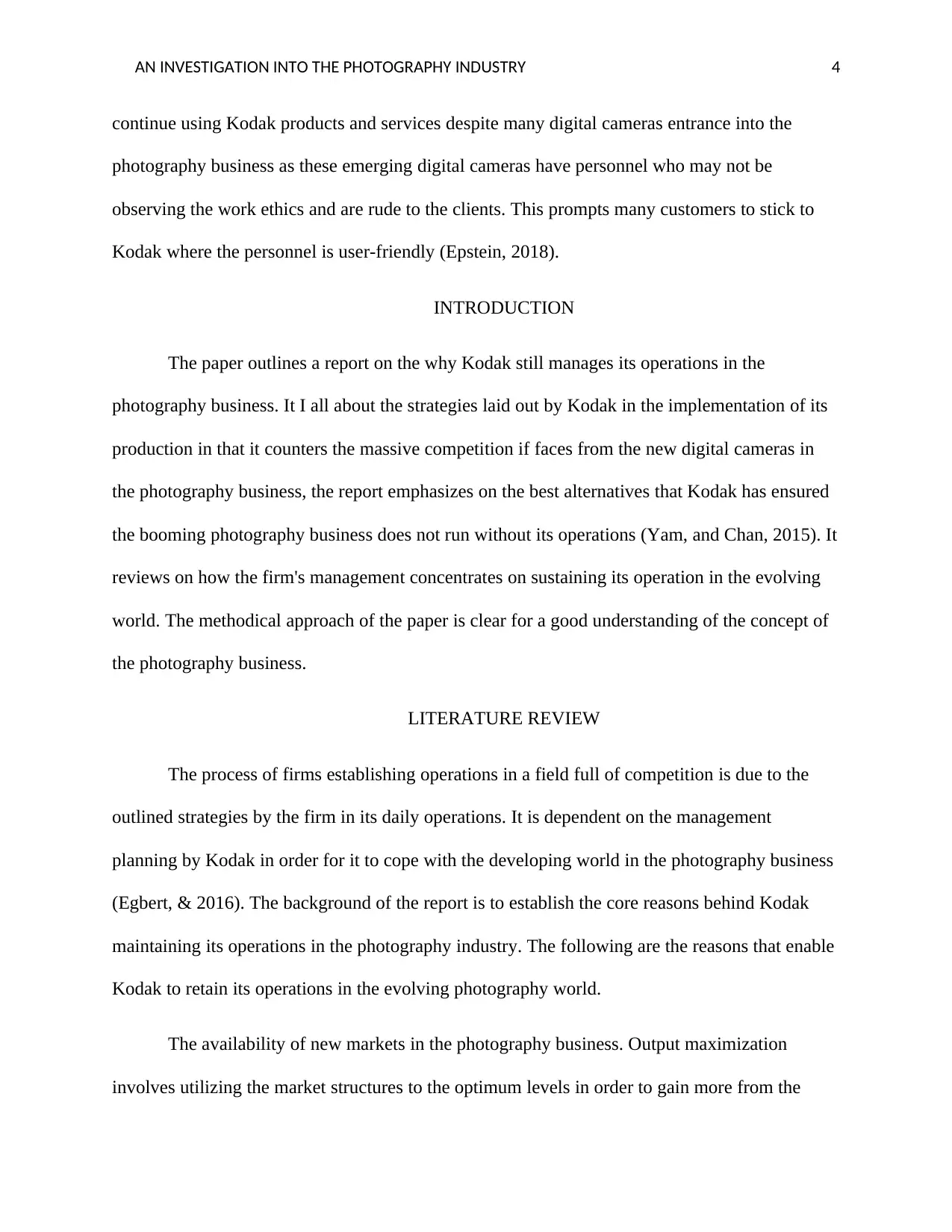
AN INVESTIGATION INTO THE PHOTOGRAPHY INDUSTRY 4
continue using Kodak products and services despite many digital cameras entrance into the
photography business as these emerging digital cameras have personnel who may not be
observing the work ethics and are rude to the clients. This prompts many customers to stick to
Kodak where the personnel is user-friendly (Epstein, 2018).
INTRODUCTION
The paper outlines a report on the why Kodak still manages its operations in the
photography business. It I all about the strategies laid out by Kodak in the implementation of its
production in that it counters the massive competition if faces from the new digital cameras in
the photography business, the report emphasizes on the best alternatives that Kodak has ensured
the booming photography business does not run without its operations (Yam, and Chan, 2015). It
reviews on how the firm's management concentrates on sustaining its operation in the evolving
world. The methodical approach of the paper is clear for a good understanding of the concept of
the photography business.
LITERATURE REVIEW
The process of firms establishing operations in a field full of competition is due to the
outlined strategies by the firm in its daily operations. It is dependent on the management
planning by Kodak in order for it to cope with the developing world in the photography business
(Egbert, & 2016). The background of the report is to establish the core reasons behind Kodak
maintaining its operations in the photography industry. The following are the reasons that enable
Kodak to retain its operations in the evolving photography world.
The availability of new markets in the photography business. Output maximization
involves utilizing the market structures to the optimum levels in order to gain more from the
continue using Kodak products and services despite many digital cameras entrance into the
photography business as these emerging digital cameras have personnel who may not be
observing the work ethics and are rude to the clients. This prompts many customers to stick to
Kodak where the personnel is user-friendly (Epstein, 2018).
INTRODUCTION
The paper outlines a report on the why Kodak still manages its operations in the
photography business. It I all about the strategies laid out by Kodak in the implementation of its
production in that it counters the massive competition if faces from the new digital cameras in
the photography business, the report emphasizes on the best alternatives that Kodak has ensured
the booming photography business does not run without its operations (Yam, and Chan, 2015). It
reviews on how the firm's management concentrates on sustaining its operation in the evolving
world. The methodical approach of the paper is clear for a good understanding of the concept of
the photography business.
LITERATURE REVIEW
The process of firms establishing operations in a field full of competition is due to the
outlined strategies by the firm in its daily operations. It is dependent on the management
planning by Kodak in order for it to cope with the developing world in the photography business
(Egbert, & 2016). The background of the report is to establish the core reasons behind Kodak
maintaining its operations in the photography industry. The following are the reasons that enable
Kodak to retain its operations in the evolving photography world.
The availability of new markets in the photography business. Output maximization
involves utilizing the market structures to the optimum levels in order to gain more from the
Paraphrase This Document
Need a fresh take? Get an instant paraphrase of this document with our AI Paraphraser
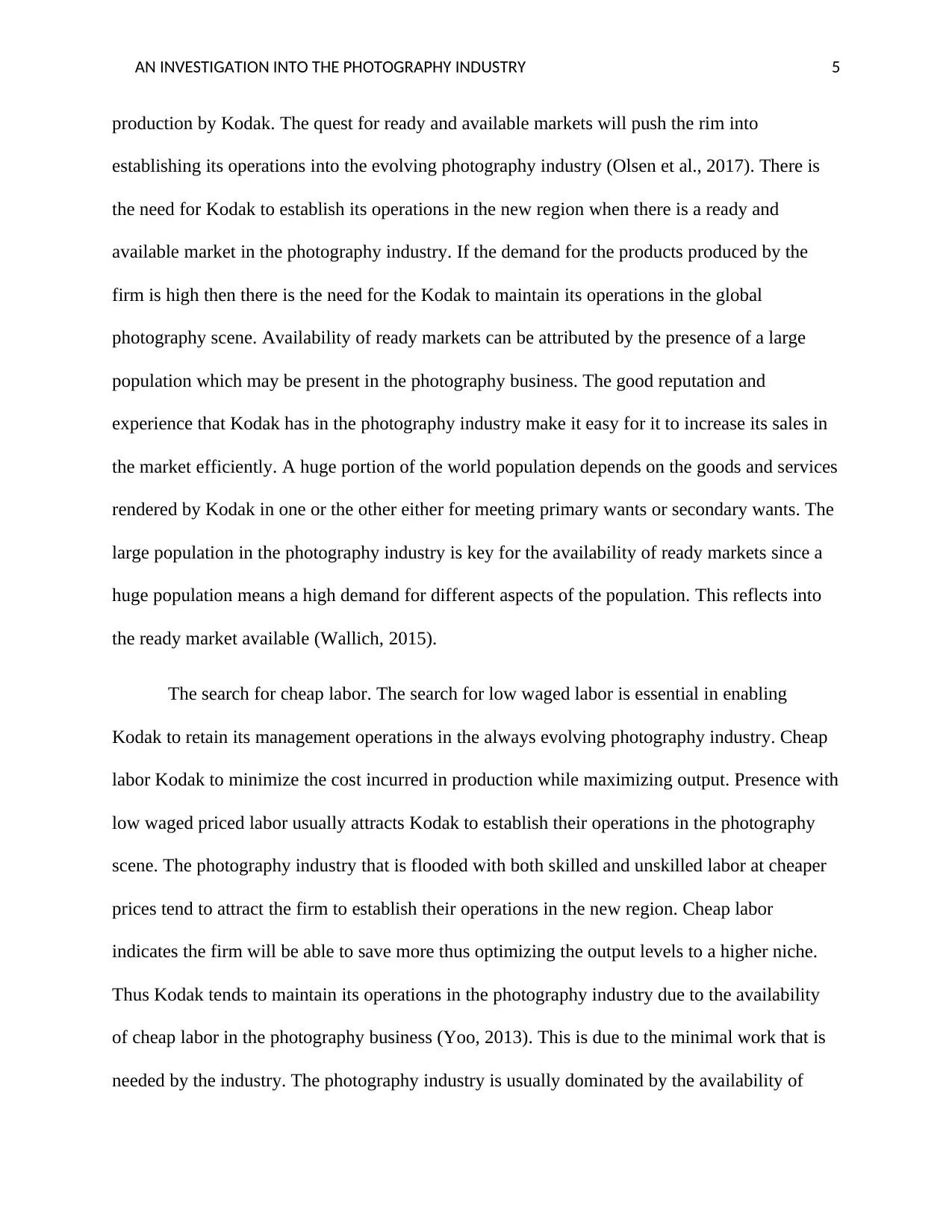
AN INVESTIGATION INTO THE PHOTOGRAPHY INDUSTRY 5
production by Kodak. The quest for ready and available markets will push the rim into
establishing its operations into the evolving photography industry (Olsen et al., 2017). There is
the need for Kodak to establish its operations in the new region when there is a ready and
available market in the photography industry. If the demand for the products produced by the
firm is high then there is the need for the Kodak to maintain its operations in the global
photography scene. Availability of ready markets can be attributed by the presence of a large
population which may be present in the photography business. The good reputation and
experience that Kodak has in the photography industry make it easy for it to increase its sales in
the market efficiently. A huge portion of the world population depends on the goods and services
rendered by Kodak in one or the other either for meeting primary wants or secondary wants. The
large population in the photography industry is key for the availability of ready markets since a
huge population means a high demand for different aspects of the population. This reflects into
the ready market available (Wallich, 2015).
The search for cheap labor. The search for low waged labor is essential in enabling
Kodak to retain its management operations in the always evolving photography industry. Cheap
labor Kodak to minimize the cost incurred in production while maximizing output. Presence with
low waged priced labor usually attracts Kodak to establish their operations in the photography
scene. The photography industry that is flooded with both skilled and unskilled labor at cheaper
prices tend to attract the firm to establish their operations in the new region. Cheap labor
indicates the firm will be able to save more thus optimizing the output levels to a higher niche.
Thus Kodak tends to maintain its operations in the photography industry due to the availability
of cheap labor in the photography business (Yoo, 2013). This is due to the minimal work that is
needed by the industry. The photography industry is usually dominated by the availability of
production by Kodak. The quest for ready and available markets will push the rim into
establishing its operations into the evolving photography industry (Olsen et al., 2017). There is
the need for Kodak to establish its operations in the new region when there is a ready and
available market in the photography industry. If the demand for the products produced by the
firm is high then there is the need for the Kodak to maintain its operations in the global
photography scene. Availability of ready markets can be attributed by the presence of a large
population which may be present in the photography business. The good reputation and
experience that Kodak has in the photography industry make it easy for it to increase its sales in
the market efficiently. A huge portion of the world population depends on the goods and services
rendered by Kodak in one or the other either for meeting primary wants or secondary wants. The
large population in the photography industry is key for the availability of ready markets since a
huge population means a high demand for different aspects of the population. This reflects into
the ready market available (Wallich, 2015).
The search for cheap labor. The search for low waged labor is essential in enabling
Kodak to retain its management operations in the always evolving photography industry. Cheap
labor Kodak to minimize the cost incurred in production while maximizing output. Presence with
low waged priced labor usually attracts Kodak to establish their operations in the photography
scene. The photography industry that is flooded with both skilled and unskilled labor at cheaper
prices tend to attract the firm to establish their operations in the new region. Cheap labor
indicates the firm will be able to save more thus optimizing the output levels to a higher niche.
Thus Kodak tends to maintain its operations in the photography industry due to the availability
of cheap labor in the photography business (Yoo, 2013). This is due to the minimal work that is
needed by the industry. The photography industry is usually dominated by the availability of

AN INVESTIGATION INTO THE PHOTOGRAPHY INDUSTRY 6
minimum wage price for labor while enhancing the labor rights for social sustainability Hence
Kodak will continue with operations for the sake of saving in terms of labor that is offered in the
photography industry. This enables the firm in minimizing the inputs while maximizing output in
its management operations.
The availability of raw materials. There is the need for Kodak to evaluate keenly the raw
materials that it needs in production. It is essential for the firm management to locate their
premises in areas where there are raw materials for the products produced by the firm. This is
key in ensuring that the costs that could be incurred during the transportation of the raw materials
to the firms for processing are reduced thus saved (Seuring et al., 2018). This mechanism enables
Kodak to maximize the output levels as the input in production is reduced in order to minimize
the input in production and maximize the production levels. The initial process of production
used in production by Kodak requires ready and available raw materials for a swift flow in the
operations of the management in ensuring that operations in the firm sun smoothly. The
proximity distance to the raw materials being near is a good indicator as the firm will be able to
minimize inputs while maximizing output (Olson, et al., 2018). The availability of raw materials
to be used in the production process by Kodak is key in its operations being in existence despite
the fact that more digital camera firms enter the competitive market.
The quest for more profits. The opportunity of Maximizing profits then obligates Kodak
to establish its operations in the photography industry where there are many chances of profit
maximization. Then if there are opportunities in the new region, the firm tends to open up its
operation in the new region. The main objectives and aims of Kodak are to minimize inputs in
production while maximizing output. All these have the essence of maximizing profits. Firms in
the photography industry are usually obsessed with the urge to make more profits. In the case
minimum wage price for labor while enhancing the labor rights for social sustainability Hence
Kodak will continue with operations for the sake of saving in terms of labor that is offered in the
photography industry. This enables the firm in minimizing the inputs while maximizing output in
its management operations.
The availability of raw materials. There is the need for Kodak to evaluate keenly the raw
materials that it needs in production. It is essential for the firm management to locate their
premises in areas where there are raw materials for the products produced by the firm. This is
key in ensuring that the costs that could be incurred during the transportation of the raw materials
to the firms for processing are reduced thus saved (Seuring et al., 2018). This mechanism enables
Kodak to maximize the output levels as the input in production is reduced in order to minimize
the input in production and maximize the production levels. The initial process of production
used in production by Kodak requires ready and available raw materials for a swift flow in the
operations of the management in ensuring that operations in the firm sun smoothly. The
proximity distance to the raw materials being near is a good indicator as the firm will be able to
minimize inputs while maximizing output (Olson, et al., 2018). The availability of raw materials
to be used in the production process by Kodak is key in its operations being in existence despite
the fact that more digital camera firms enter the competitive market.
The quest for more profits. The opportunity of Maximizing profits then obligates Kodak
to establish its operations in the photography industry where there are many chances of profit
maximization. Then if there are opportunities in the new region, the firm tends to open up its
operation in the new region. The main objectives and aims of Kodak are to minimize inputs in
production while maximizing output. All these have the essence of maximizing profits. Firms in
the photography industry are usually obsessed with the urge to make more profits. In the case
⊘ This is a preview!⊘
Do you want full access?
Subscribe today to unlock all pages.

Trusted by 1+ million students worldwide

AN INVESTIGATION INTO THE PHOTOGRAPHY INDUSTRY 7
example of Kodak, the management aims at making more profits in the industry. Hence with its
global reputation, Kodak is able to utilize the opportunity of its bestselling brand to continue
accruing more profits in the photography industry. Kodak still exists in the photography industry
due to this (Khoja, Adams, & Kauffman, 2016). Every firm is always after making more profits
for it to pay bills and sustain itself. Hence due to the quest for more profits, Kodak will have to
continue operating in the photography industry with the core essence of making more profits.
This can be illustrated as the retention of Kodak’s operations in an industry full of
competition from the emerging digital cameras has been a huge contribution to the expansion of
market and production. The photography industry is usually a very competitive platform.
However whatever matters most is the reputation that a firm has in the market out there. The
experience and reputation of a firm are key here. Kodak has got a vast knowledge and experience
in the field of photography. This has enabled it to make more sales in the industry than the
upcoming digital cameras in the industry. Firms usually look for the slightest opportunity to
extend their operations into the photography industry (Nylén and Holmström, 2015). Thus the
above are the reasons behind Kodak continuity with operations in the photography industry
despite the fact that many digital cameras emerging in the photography business.
RESEARCH PLAN
The functionality played by this research is to identify and internalize the strategies by
Kodak that enable it to maintain its operations in the photography industry. There is the need for
Kodak extending its operations to the photography industry as there will be advancements in the
operations of Kodak. The input in production will be minimized while output for the production
is maximized. It is the ultimate responsibility for Kodak’s management to establish its operations
in the photography industry. The management of the firm analyses the new region critically in
example of Kodak, the management aims at making more profits in the industry. Hence with its
global reputation, Kodak is able to utilize the opportunity of its bestselling brand to continue
accruing more profits in the photography industry. Kodak still exists in the photography industry
due to this (Khoja, Adams, & Kauffman, 2016). Every firm is always after making more profits
for it to pay bills and sustain itself. Hence due to the quest for more profits, Kodak will have to
continue operating in the photography industry with the core essence of making more profits.
This can be illustrated as the retention of Kodak’s operations in an industry full of
competition from the emerging digital cameras has been a huge contribution to the expansion of
market and production. The photography industry is usually a very competitive platform.
However whatever matters most is the reputation that a firm has in the market out there. The
experience and reputation of a firm are key here. Kodak has got a vast knowledge and experience
in the field of photography. This has enabled it to make more sales in the industry than the
upcoming digital cameras in the industry. Firms usually look for the slightest opportunity to
extend their operations into the photography industry (Nylén and Holmström, 2015). Thus the
above are the reasons behind Kodak continuity with operations in the photography industry
despite the fact that many digital cameras emerging in the photography business.
RESEARCH PLAN
The functionality played by this research is to identify and internalize the strategies by
Kodak that enable it to maintain its operations in the photography industry. There is the need for
Kodak extending its operations to the photography industry as there will be advancements in the
operations of Kodak. The input in production will be minimized while output for the production
is maximized. It is the ultimate responsibility for Kodak’s management to establish its operations
in the photography industry. The management of the firm analyses the new region critically in
Paraphrase This Document
Need a fresh take? Get an instant paraphrase of this document with our AI Paraphraser
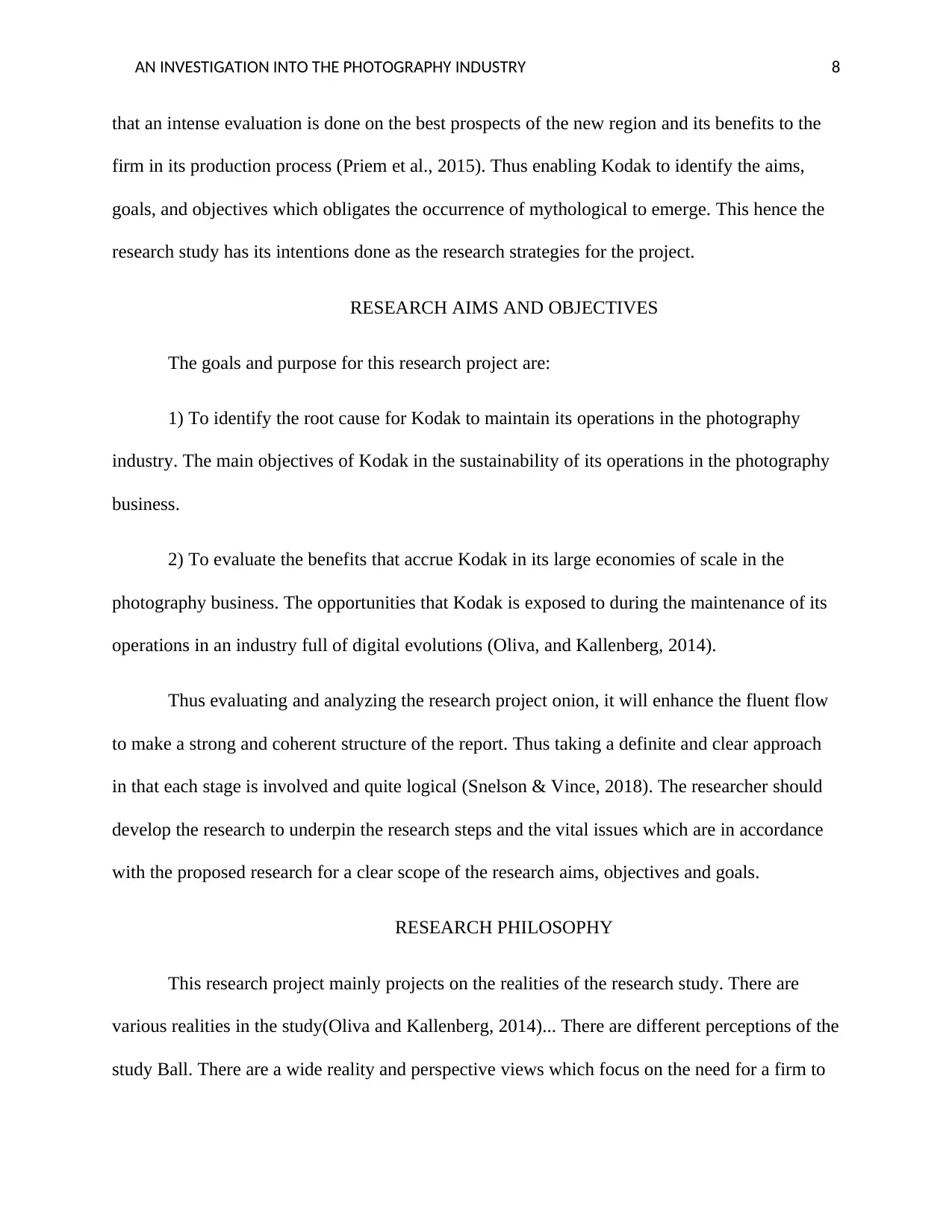
AN INVESTIGATION INTO THE PHOTOGRAPHY INDUSTRY 8
that an intense evaluation is done on the best prospects of the new region and its benefits to the
firm in its production process (Priem et al., 2015). Thus enabling Kodak to identify the aims,
goals, and objectives which obligates the occurrence of mythological to emerge. This hence the
research study has its intentions done as the research strategies for the project.
RESEARCH AIMS AND OBJECTIVES
The goals and purpose for this research project are:
1) To identify the root cause for Kodak to maintain its operations in the photography
industry. The main objectives of Kodak in the sustainability of its operations in the photography
business.
2) To evaluate the benefits that accrue Kodak in its large economies of scale in the
photography business. The opportunities that Kodak is exposed to during the maintenance of its
operations in an industry full of digital evolutions (Oliva, and Kallenberg, 2014).
Thus evaluating and analyzing the research project onion, it will enhance the fluent flow
to make a strong and coherent structure of the report. Thus taking a definite and clear approach
in that each stage is involved and quite logical (Snelson & Vince, 2018). The researcher should
develop the research to underpin the research steps and the vital issues which are in accordance
with the proposed research for a clear scope of the research aims, objectives and goals.
RESEARCH PHILOSOPHY
This research project mainly projects on the realities of the research study. There are
various realities in the study(Oliva and Kallenberg, 2014)... There are different perceptions of the
study Ball. There are a wide reality and perspective views which focus on the need for a firm to
that an intense evaluation is done on the best prospects of the new region and its benefits to the
firm in its production process (Priem et al., 2015). Thus enabling Kodak to identify the aims,
goals, and objectives which obligates the occurrence of mythological to emerge. This hence the
research study has its intentions done as the research strategies for the project.
RESEARCH AIMS AND OBJECTIVES
The goals and purpose for this research project are:
1) To identify the root cause for Kodak to maintain its operations in the photography
industry. The main objectives of Kodak in the sustainability of its operations in the photography
business.
2) To evaluate the benefits that accrue Kodak in its large economies of scale in the
photography business. The opportunities that Kodak is exposed to during the maintenance of its
operations in an industry full of digital evolutions (Oliva, and Kallenberg, 2014).
Thus evaluating and analyzing the research project onion, it will enhance the fluent flow
to make a strong and coherent structure of the report. Thus taking a definite and clear approach
in that each stage is involved and quite logical (Snelson & Vince, 2018). The researcher should
develop the research to underpin the research steps and the vital issues which are in accordance
with the proposed research for a clear scope of the research aims, objectives and goals.
RESEARCH PHILOSOPHY
This research project mainly projects on the realities of the research study. There are
various realities in the study(Oliva and Kallenberg, 2014)... There are different perceptions of the
study Ball. There are a wide reality and perspective views which focus on the need for a firm to

AN INVESTIGATION INTO THE PHOTOGRAPHY INDUSTRY 9
establish its operations in a new region (Yam and Chan, 2015. Objectivism thus describes the
firm establishing its operations in the new region as being a prospective objective entity: where
the production and financial aspects of Kodak are inevitable and the differing changes in the firm
that maintains its operations in the photography industry (Schönsleben, 2016).
METHODOLOGICAL STRATEGIES, CHOICES, AND APPROACHES.
This project is a useful technique in a case study of Kodak maintaining its operations in
the always evolving photography industry. Thus the research proposal is a good example of the
utilities derived from the real world case. This is key in ensuring that the researcher gains the
required understanding in the study, the researcher is thus in the position to study and challenge
the involved theory in the research proposal (Mayer, and Wang, 2016), this is key in enabling
answers to be answered properly. Thus the exploration of extensive research and the
methodological preferences and choices are as a result of the strategies thus providing an
ultimate procedure and guideline in the optimization of the goals of the Kodak films. The
triangulation of the data collected will enable that the data demonstrated is the way it should be.
Data analysis is key in ensuring that the research plan in successful to its top-notch levels.
The quantitative analysis of the data in the plan is key in the plan. Qualitative research is also
vital in the enabling of the successful planning of the project. The importance of the levels in the
research study enables the transformation of data (Taleb, Gibson, & Hovey, 2015). The
transformation of the data tends to add value to the data collected regardless of the time
consumed during the transformation thus several phases of researches. Although this is risky and
the significance is also present.
establish its operations in a new region (Yam and Chan, 2015. Objectivism thus describes the
firm establishing its operations in the new region as being a prospective objective entity: where
the production and financial aspects of Kodak are inevitable and the differing changes in the firm
that maintains its operations in the photography industry (Schönsleben, 2016).
METHODOLOGICAL STRATEGIES, CHOICES, AND APPROACHES.
This project is a useful technique in a case study of Kodak maintaining its operations in
the always evolving photography industry. Thus the research proposal is a good example of the
utilities derived from the real world case. This is key in ensuring that the researcher gains the
required understanding in the study, the researcher is thus in the position to study and challenge
the involved theory in the research proposal (Mayer, and Wang, 2016), this is key in enabling
answers to be answered properly. Thus the exploration of extensive research and the
methodological preferences and choices are as a result of the strategies thus providing an
ultimate procedure and guideline in the optimization of the goals of the Kodak films. The
triangulation of the data collected will enable that the data demonstrated is the way it should be.
Data analysis is key in ensuring that the research plan in successful to its top-notch levels.
The quantitative analysis of the data in the plan is key in the plan. Qualitative research is also
vital in the enabling of the successful planning of the project. The importance of the levels in the
research study enables the transformation of data (Taleb, Gibson, & Hovey, 2015). The
transformation of the data tends to add value to the data collected regardless of the time
consumed during the transformation thus several phases of researches. Although this is risky and
the significance is also present.
⊘ This is a preview!⊘
Do you want full access?
Subscribe today to unlock all pages.

Trusted by 1+ million students worldwide
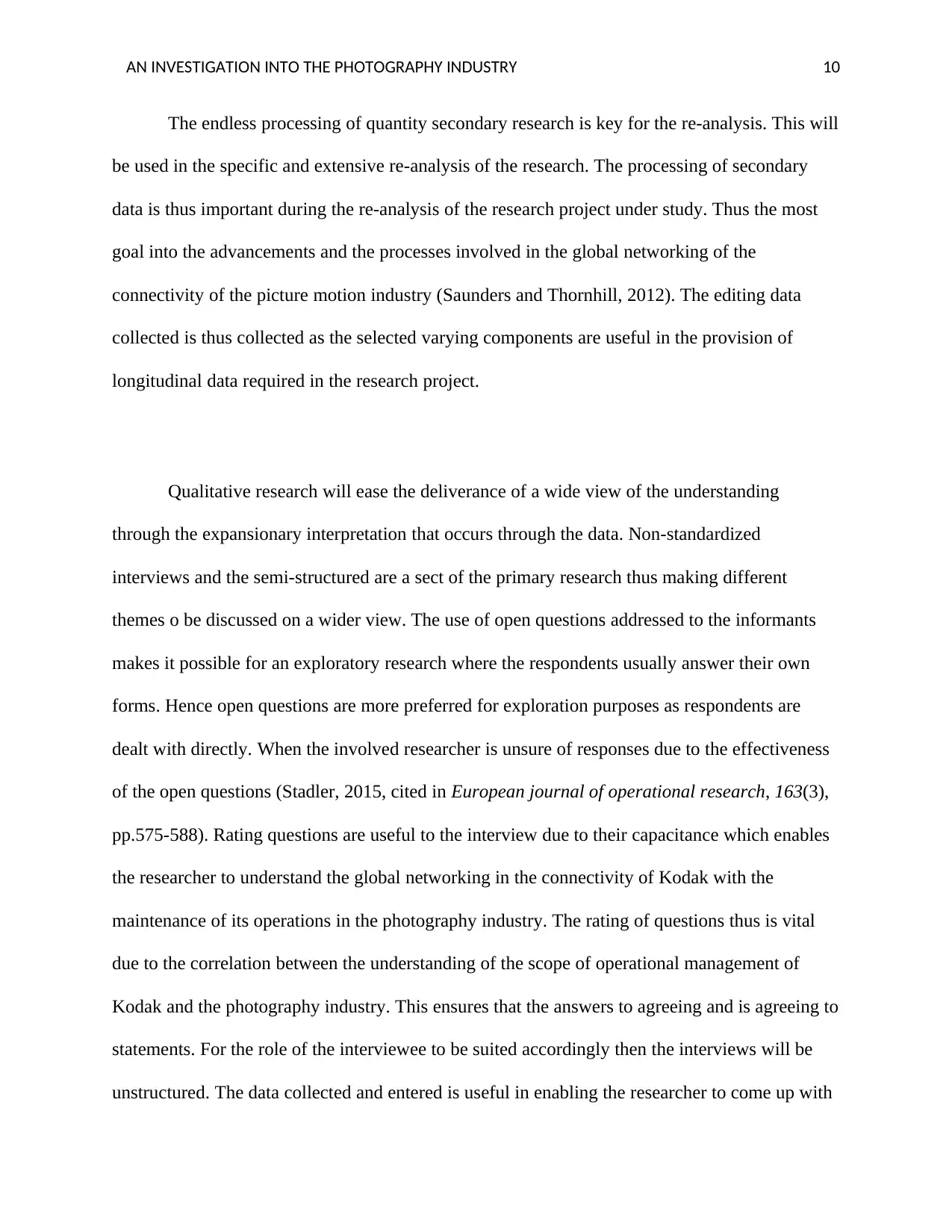
AN INVESTIGATION INTO THE PHOTOGRAPHY INDUSTRY 10
The endless processing of quantity secondary research is key for the re-analysis. This will
be used in the specific and extensive re-analysis of the research. The processing of secondary
data is thus important during the re-analysis of the research project under study. Thus the most
goal into the advancements and the processes involved in the global networking of the
connectivity of the picture motion industry (Saunders and Thornhill, 2012). The editing data
collected is thus collected as the selected varying components are useful in the provision of
longitudinal data required in the research project.
Qualitative research will ease the deliverance of a wide view of the understanding
through the expansionary interpretation that occurs through the data. Non-standardized
interviews and the semi-structured are a sect of the primary research thus making different
themes o be discussed on a wider view. The use of open questions addressed to the informants
makes it possible for an exploratory research where the respondents usually answer their own
forms. Hence open questions are more preferred for exploration purposes as respondents are
dealt with directly. When the involved researcher is unsure of responses due to the effectiveness
of the open questions (Stadler, 2015, cited in European journal of operational research, 163(3),
pp.575-588). Rating questions are useful to the interview due to their capacitance which enables
the researcher to understand the global networking in the connectivity of Kodak with the
maintenance of its operations in the photography industry. The rating of questions thus is vital
due to the correlation between the understanding of the scope of operational management of
Kodak and the photography industry. This ensures that the answers to agreeing and is agreeing to
statements. For the role of the interviewee to be suited accordingly then the interviews will be
unstructured. The data collected and entered is useful in enabling the researcher to come up with
The endless processing of quantity secondary research is key for the re-analysis. This will
be used in the specific and extensive re-analysis of the research. The processing of secondary
data is thus important during the re-analysis of the research project under study. Thus the most
goal into the advancements and the processes involved in the global networking of the
connectivity of the picture motion industry (Saunders and Thornhill, 2012). The editing data
collected is thus collected as the selected varying components are useful in the provision of
longitudinal data required in the research project.
Qualitative research will ease the deliverance of a wide view of the understanding
through the expansionary interpretation that occurs through the data. Non-standardized
interviews and the semi-structured are a sect of the primary research thus making different
themes o be discussed on a wider view. The use of open questions addressed to the informants
makes it possible for an exploratory research where the respondents usually answer their own
forms. Hence open questions are more preferred for exploration purposes as respondents are
dealt with directly. When the involved researcher is unsure of responses due to the effectiveness
of the open questions (Stadler, 2015, cited in European journal of operational research, 163(3),
pp.575-588). Rating questions are useful to the interview due to their capacitance which enables
the researcher to understand the global networking in the connectivity of Kodak with the
maintenance of its operations in the photography industry. The rating of questions thus is vital
due to the correlation between the understanding of the scope of operational management of
Kodak and the photography industry. This ensures that the answers to agreeing and is agreeing to
statements. For the role of the interviewee to be suited accordingly then the interviews will be
unstructured. The data collected and entered is useful in enabling the researcher to come up with
Paraphrase This Document
Need a fresh take? Get an instant paraphrase of this document with our AI Paraphraser

AN INVESTIGATION INTO THE PHOTOGRAPHY INDUSTRY 11
the best approaches in the research. This is key in ensuring that the specification and emphasis
on the qualitative analysis of the answers and the contribution. i.e. the questions that asked to the
producers of the firm production in the new region will not be the same from those inquired to
the staff in the film industry and results into the avoidance of the sense of offense (Athreye,
Batsakis & Singh, 2016). The respondent stands at a chance to elaborate more on the key interest
concepts. This eases the work of the researcher during the project duration in coming up with the
best choice of data and approach used. During this process of interview, the data collected are
audio recorded and transformed into the narrative form. Thus the collected data is easily
transformed into the narrative form by the researcher for easy data keeping in the research
project, this will ease the process of reference in the future. However this occurs, note taking is
also key during the interview. The parts in the interview which are dominant and prominent are
usually transcribed.
SAMPLING
In 2015, many firms made it possible for firms to enter into new regions. Due to the large
volume of data, there is the successful investigation of the sample in use (Olsen et al., 2017).
However, the chosen sample has to be in order in that the primary data collected for proper
analysis accordingly, a non-probability structure in the sampling criteria enables the choosing of
the preferred sample. This also ensures that the members of the population who are difficult to
trace their existence are easily sorted as the non-probability structure sampling is one that fits
this properly. The quota sampling is a type of sampling technique which is a derivative of non-
random selection of the element to study. This usually enables that each stratum that is in use has
an allocated quota. However, the various approaches of sampling are used for various interview
types.
the best approaches in the research. This is key in ensuring that the specification and emphasis
on the qualitative analysis of the answers and the contribution. i.e. the questions that asked to the
producers of the firm production in the new region will not be the same from those inquired to
the staff in the film industry and results into the avoidance of the sense of offense (Athreye,
Batsakis & Singh, 2016). The respondent stands at a chance to elaborate more on the key interest
concepts. This eases the work of the researcher during the project duration in coming up with the
best choice of data and approach used. During this process of interview, the data collected are
audio recorded and transformed into the narrative form. Thus the collected data is easily
transformed into the narrative form by the researcher for easy data keeping in the research
project, this will ease the process of reference in the future. However this occurs, note taking is
also key during the interview. The parts in the interview which are dominant and prominent are
usually transcribed.
SAMPLING
In 2015, many firms made it possible for firms to enter into new regions. Due to the large
volume of data, there is the successful investigation of the sample in use (Olsen et al., 2017).
However, the chosen sample has to be in order in that the primary data collected for proper
analysis accordingly, a non-probability structure in the sampling criteria enables the choosing of
the preferred sample. This also ensures that the members of the population who are difficult to
trace their existence are easily sorted as the non-probability structure sampling is one that fits
this properly. The quota sampling is a type of sampling technique which is a derivative of non-
random selection of the element to study. This usually enables that each stratum that is in use has
an allocated quota. However, the various approaches of sampling are used for various interview
types.
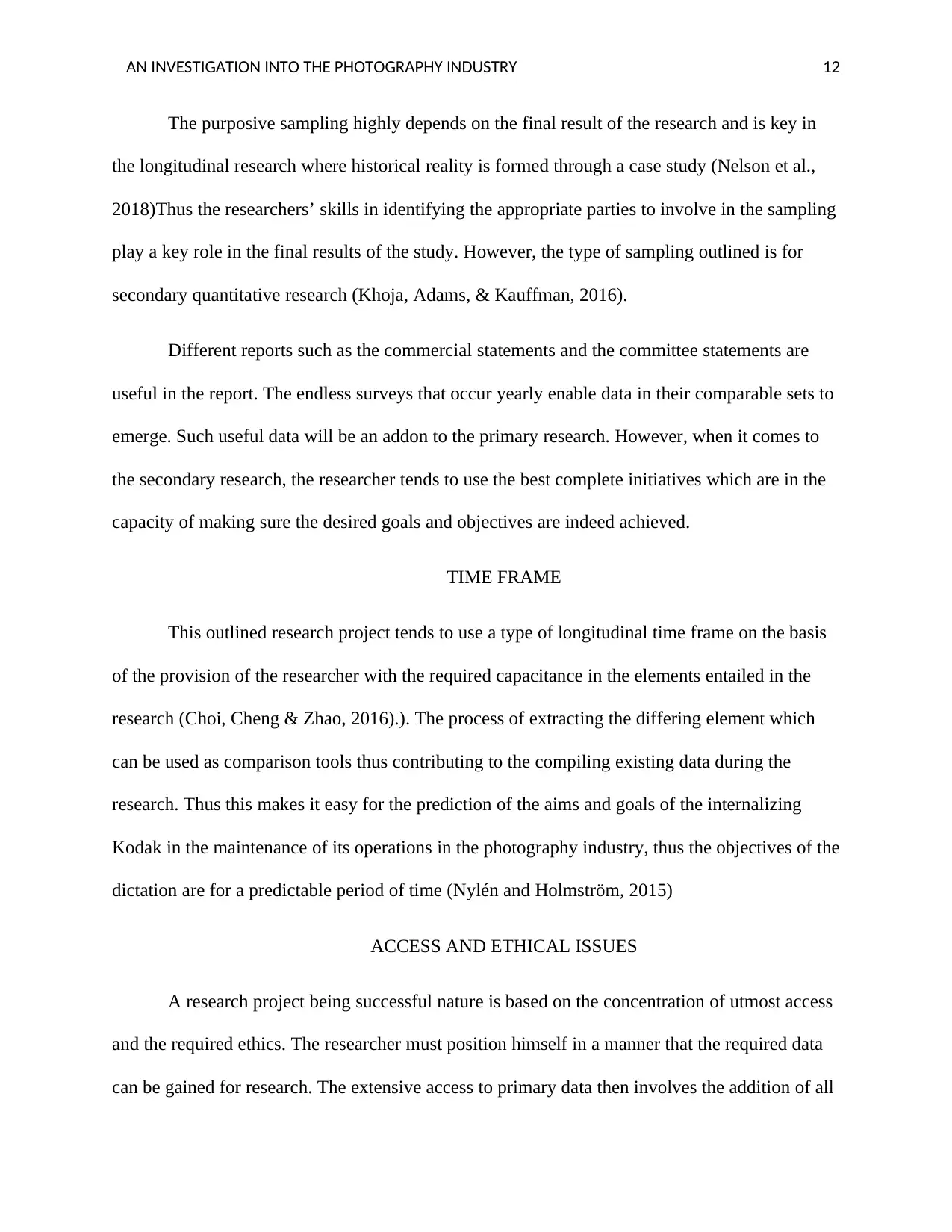
AN INVESTIGATION INTO THE PHOTOGRAPHY INDUSTRY 12
The purposive sampling highly depends on the final result of the research and is key in
the longitudinal research where historical reality is formed through a case study (Nelson et al.,
2018)Thus the researchers’ skills in identifying the appropriate parties to involve in the sampling
play a key role in the final results of the study. However, the type of sampling outlined is for
secondary quantitative research (Khoja, Adams, & Kauffman, 2016).
Different reports such as the commercial statements and the committee statements are
useful in the report. The endless surveys that occur yearly enable data in their comparable sets to
emerge. Such useful data will be an addon to the primary research. However, when it comes to
the secondary research, the researcher tends to use the best complete initiatives which are in the
capacity of making sure the desired goals and objectives are indeed achieved.
TIME FRAME
This outlined research project tends to use a type of longitudinal time frame on the basis
of the provision of the researcher with the required capacitance in the elements entailed in the
research (Choi, Cheng & Zhao, 2016).). The process of extracting the differing element which
can be used as comparison tools thus contributing to the compiling existing data during the
research. Thus this makes it easy for the prediction of the aims and goals of the internalizing
Kodak in the maintenance of its operations in the photography industry, thus the objectives of the
dictation are for a predictable period of time (Nylén and Holmström, 2015)
ACCESS AND ETHICAL ISSUES
A research project being successful nature is based on the concentration of utmost access
and the required ethics. The researcher must position himself in a manner that the required data
can be gained for research. The extensive access to primary data then involves the addition of all
The purposive sampling highly depends on the final result of the research and is key in
the longitudinal research where historical reality is formed through a case study (Nelson et al.,
2018)Thus the researchers’ skills in identifying the appropriate parties to involve in the sampling
play a key role in the final results of the study. However, the type of sampling outlined is for
secondary quantitative research (Khoja, Adams, & Kauffman, 2016).
Different reports such as the commercial statements and the committee statements are
useful in the report. The endless surveys that occur yearly enable data in their comparable sets to
emerge. Such useful data will be an addon to the primary research. However, when it comes to
the secondary research, the researcher tends to use the best complete initiatives which are in the
capacity of making sure the desired goals and objectives are indeed achieved.
TIME FRAME
This outlined research project tends to use a type of longitudinal time frame on the basis
of the provision of the researcher with the required capacitance in the elements entailed in the
research (Choi, Cheng & Zhao, 2016).). The process of extracting the differing element which
can be used as comparison tools thus contributing to the compiling existing data during the
research. Thus this makes it easy for the prediction of the aims and goals of the internalizing
Kodak in the maintenance of its operations in the photography industry, thus the objectives of the
dictation are for a predictable period of time (Nylén and Holmström, 2015)
ACCESS AND ETHICAL ISSUES
A research project being successful nature is based on the concentration of utmost access
and the required ethics. The researcher must position himself in a manner that the required data
can be gained for research. The extensive access to primary data then involves the addition of all
⊘ This is a preview!⊘
Do you want full access?
Subscribe today to unlock all pages.

Trusted by 1+ million students worldwide
1 out of 20
Related Documents
Your All-in-One AI-Powered Toolkit for Academic Success.
+13062052269
info@desklib.com
Available 24*7 on WhatsApp / Email
![[object Object]](/_next/static/media/star-bottom.7253800d.svg)
Unlock your academic potential
Copyright © 2020–2025 A2Z Services. All Rights Reserved. Developed and managed by ZUCOL.





